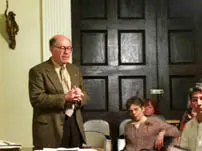In the early part of the century, between 1905 and 1915, Jersey City looked much the same as it does now, cluttered with construction machinery and pelted with the unyielding sounds of jackhammers and bulldozers. It was the most prosperous time in Jersey City’s history, according to historians, which is why the newest edition of the book “Jersey City in Vintage Postcards” takes most of its images from that period. The book is one of many in a series entitled “Images of America.” At the monthly meeting of the Van Vorst Park Association last week, the author of the book, Randall Gabrielan, was on hand for a short slide presentation and book signing. “There’s a lot of history here,” Gabrielan said of his native Jersey City. “There was no television, and newspapers published very few photos. Photographic postcards served as the news picture of its day.” The book is a collection of photographs of people and places around the city, some of which no longer exist outside of history books and memory. Photos in this most recent edition of the book capture the Colgate Clock, the old Exchange Place and City Hall. All of the pictures reveal the effects time has had on the city. For example, the images of Exchange Place were taken when that part of the city served at the eastern-most terminus of the railroads. The photos of City Hall were taken well before a 1979 fire clipped towering chapels from the roof. Tracking the changes in history is one of the author’s biggest challenges. “It’s very fascinating to me and it’s a very important part of the job,” he said. Sometimes Gabrielan would venture to a certain site and find that the pictured structures no longer exist. Such was the case when he investigated photos of row homes that lined Ocean Avenue in the early part of the century. “Lots has changed,” Gabrielan said of the street now occupied by affordable housing and retail space. But such changes are the norm, according to the Monmouth County-based writer and historian. “It’s typical of what’s happening to the cities,” Gabrielan said. “It’s the same story over and over again. The population changes, grows old, and new businesses develop.” The book comes on the heels of the old Hudson & Manhattan Powerhouse’s appearance on a preservation group’s list of endangered historical sites. Being on the list will qualify the Powerhouse, which used to power the Hudson & Manhattan Railroads at the time from which most of the book’s photos come, for certain grant funds. The funds are slated to go towards extensive roof repairs on the building, for which many uses have surfaced from interested parties. One such use is to make the building into a museum. Gabrielan said that preservation is something that communities need to continue to do, as standing structures are our only link to the past. “Preservation is very important,” the author said. “It provides an area with character, it gives us a sense of our past and where we are going. Without history, we have no tie to our present being.” For his research, Gabrielan used an extensive collection of public and private photos. Most of his materials were easily found in the New Jersey Room of the Jersey City Public Library. The facility contains endless pages, pamphlets and profiles of historic information about the city. “It’s a very good facility,” Gabrielan said. “It’s like taking a tour through time without leaving the room.” “Jersey City in Vintage Postcards,” published by Arcadia Publishing, is available at local bookstores.
Our Digital Archive from 2000 – 2016
